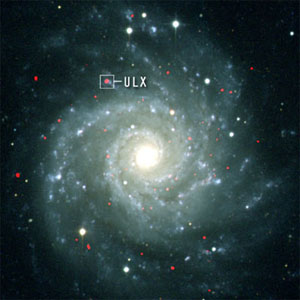X-rays Signal Presence of Elusive Black Hole (Photo)
(Clearwisdom.net) According to a Chandra X-Ray Center News Release on March 23, 2005, peculiar outbursts of X-rays coming from a black hole in the galaxy Messier 74 (M74) have provided evidence that the black hole has a mass of about 10,000 Suns, which would place it in a possible new class of black holes. These outbursts were observed with NASA's Chandra X-ray Observatory.
This composite X-ray (red)/optical (blue & white) image of the spiral galaxy M74 highlights an ultraluminous X-ray source (ULX) shown in the box. ULX sources are distinctive because they radiate 10 to 1000 times more X-ray power than neutron stars and stellar mass black holes. Chandra observations of this ULX have provided evidence that its X-radiation is produced by a disk of hot gas swirling around a black hole with a mass of about 10,000 Suns. Credit: X-ray: NASA/CXC/U. of Michigan/J.Liu et al.; Optical: NOAO/AURA/NSF/T.Boroson
Astronomers used Chandra to observe a black hole in the galaxy Messier 74 (M74), which is about 32 million light years from Earth. They found that this source exhibits strong, nearly periodic variations in its X-ray brightness every two hours, providing an important clue to the black holes' mass. The black hole also fell into a class of sources called ultraluminous X-ray sources (ULXs) because they radiate 10 to 1000 times more x-ray power than neutron stars and stellar mass black holes. The observed two-hour variation implies that this ULX has a mass of about 10,000 Suns.
Scientists have strong evidence for the existence of stellar black holes that are about 10 times as massive as the Sun. They have also discovered that supermassive black holes with masses as large as billions of Suns exist in the centers of most galaxies. Recent evidence has suggested that a new class of black holes may exist between these extremes -- intermediate-mass black holes with masses equal to thousands of Suns.
Reference: http://www.spaceflightnow.com/news/n0503/23blackhole/
